Dancing with Sage Grouse
By Bruce Mast
Editor’s note: If you would like to experience Sage Grouse for yourself, we currently have one spot available for our March 22nd trip. For more information and registration go to https://goldengatebirdalliance.org/birdathon-2019-fundraising-trips/
The eastern sky was just beginning to glow pink. We were cold. It was early spring in the eastern Sierras and we were cold. And under-caffeinated. We had been up since 4 a.m., bundling into our down and fleece, driving since 5 a.m. past the High Desert State Prison, and then trudging up the flank of Shaffer Mountain to shiver expectantly on the side of a rutted jeep road. We were 20 hardy souls from Golden Gate Bird Alliance, under the veteran leadership of Dave Quady. Why had we journeyed northeast to Susanville to visit such a desolate place? The answer came soon enough.
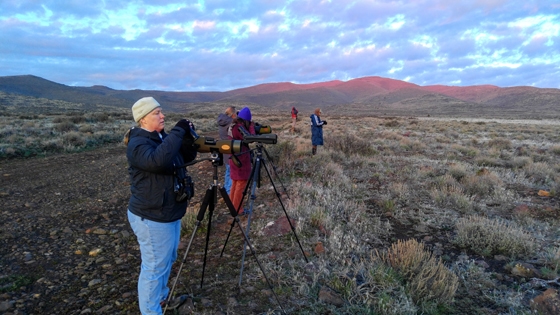
The answer came quietly—low, muffled plopping sounds from the north. A binocular scan revealed an expanse of yellow, lava-strewn grass interrupting the sagebrush sea. But some of the rocks were moving! As morning light spread over the landscape, the tableau came into focus. Greater Sage Grouse, those enigmatic denizens of Basin and Range sagebrush country, were gathering for their annual lekking ritual. Wikipedia tells us that a lek is an aggregation of male animals gathered to engage in competitive displays to entice visiting females, which are surveying prospective mates. The term derives from the Swedish “lek”, a noun which typically translates as “play”. The term was originally used for Black Grouse (Swedish: “orrlek”) and for Western Capercaillie (Swedish: “tjäderlek”).
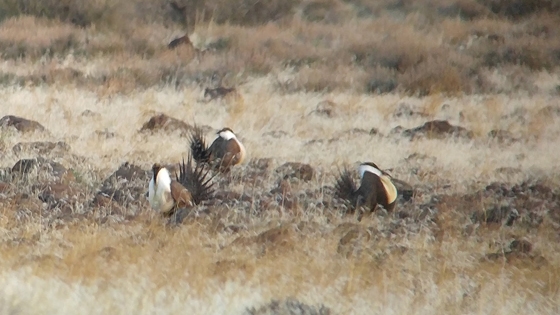
On this morning, multiple male Sage Grouse strutted regally, their spiky tails fanned, white feathering on the sides and back of their necks forming a royal ruff. Large air sacs on their breasts suggested avian bagpipes. Scope views revealed large yellow bare patches on their breasts, a yellow fleshy comb above the eye, and wispy filoplumes extending from their nape.
The dominant males held court in the center of the lek, challenging newcomers for status and position. Most interactions involved choreographed strutting and posturing but occasionally a wing fight was required to put a young male in his place.
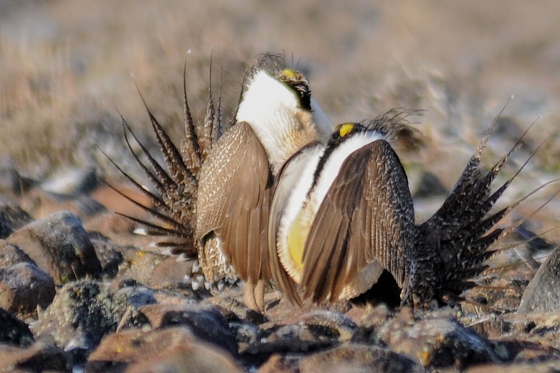
How many birds were there? In some years, I had counted as few as a half dozen males but this year repeated scans consistently tallied 25. But where were the females? They were present but extra challenging to pick out. Lacking the males’ gaudy displays, they blended in with the rocks. They mostly held still and watched, revealing themselves only when they moved. On this day, I was able to discern five, probably an undercount.
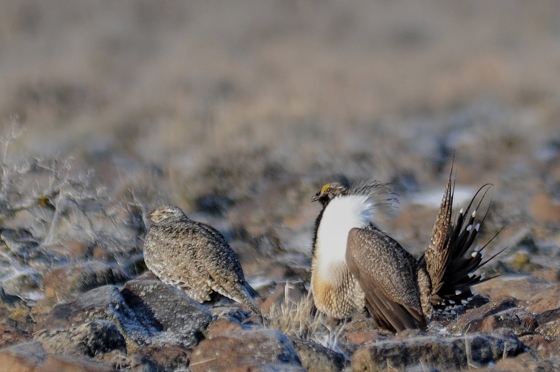
As the sun climbed over the eastern mountains, the stark beauty of the landscape was fully revealed. Snow blanketed the higher peaks. Black volcanic outcrops punctuated the gray sagebrush slopes. In the distance, a Pronghorn herd picked its way along the ridge. A Prairie Falcon blazed over at falcon speed. The songs of Western Meadowlarks and Horned Larks filled the air. Warmer and delighted, we made our way back to the vehicles, where a couple singing Sage Thrashers and Sagebrush Sparrows completed the sage bird trifecta.
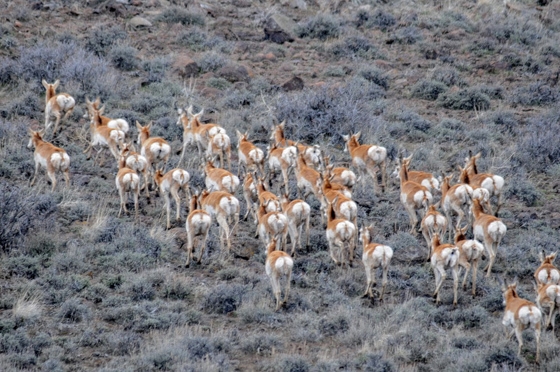
A visit to the Sage Grouse lek is an unforgettable experience but it was just the beginning of a memorable two-day field trip. After retreating to town to thaw out over breakfast and coffee, we set out again, first visiting Susan River Park and the Bizz Johnson Trail, near downtown Susanville. We scanned the Susan River carefully for American Dippers. I’ve seen them here twice in my nine visits but not this year. No matter; Mountain Chickadees, a Townsend’s Solitaire, and a couple dozen other species held our interest. In some years, neighborhood feeders have attracted flocks of Evening Grosbeaks.
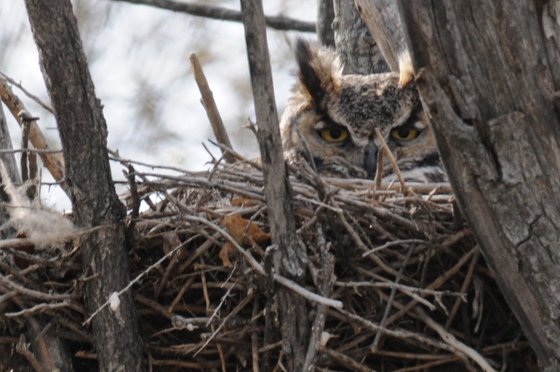
We spent much of Saturday birding the various ponds and lakes around Honey Lake, tallying an assortment of waterfowl and waders, including a flock of 2,000 Snow Geese. Honey Lake Wildlife Area produced our first Sandhill Crane and Sharp-shinned, Ferruginous, and Rough-legged Hawks. The large trees around a ranch house concealed a Great Horned Owl. Black-bird flocks included a handful of Yellow-headed Blackbirds. We trekked over to the eastern side of Honey Lake to visit the volcanic cliffs, where we were greeted by Rock Wrens and Say’s Phoebes. The Chukars that inhabit these bluffs were silent.
Downtown Susanville is not known as a fine food mecca but Lassen Ale Works has emerged as a dependable spot for good pub food and microbrews. Eight house brews cater to hop-heads and malt-heads alike. The menu includes good soups and salads for more conscientious eaters. Our lodging at the Best Western was clean and comfortable and they give us a group discount.
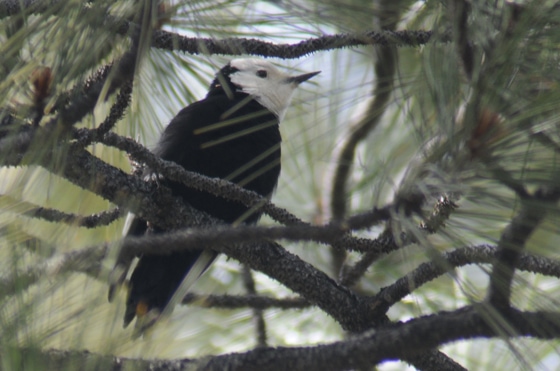
Sunday’s outing took us to Jack’s Valley and then to Eagle Lake. The day’s theme was mountain birds: Mountain Bluebirds, Mountain Chickadees, Cassin’s Finches, White-headed Woodpeckers, Clark’s Nutcracker, Townsend’s Solitaires, and more. The marshy grasslands around Willow Creek Wildlife Area hosted flocks of Greater White-fronted Geese, Sandhill Cranes, and Wilson’s Snipes. Eagle Lake is a dependable spot for Bald Eagles and one year we found an active nest. Less dependable are the Pinyon Jay flocks. In good years, we have located dozens of beautiful blue birds, squawking and flitting from tree to tree as the flock moves across the landscape. These birds wander widely in search of ripe pinyon pine seeds so their location is unpredictable. I’ve found them five times in nine trips. Alas, this year it was not to be.
Our trip ended with a visit to the lakeside chalet of Dave’s good friends, Lew and Kay Oring. A now-retired ornithology professor, Lew spent many years primarily studying shorebird mating biology, but he’s also been long interested in Greater Sage-Grouse and other eastern Sierra species, so it was a true privilege to listen to his tales as we ate our lunch. A big picture window and balcony gave us ring-side seats to the Orings’ bird feeder array. We reluctantly left their cozy confines and started south with a new appreciation for this beautiful landscape and the birds and wildlife that make it their home.
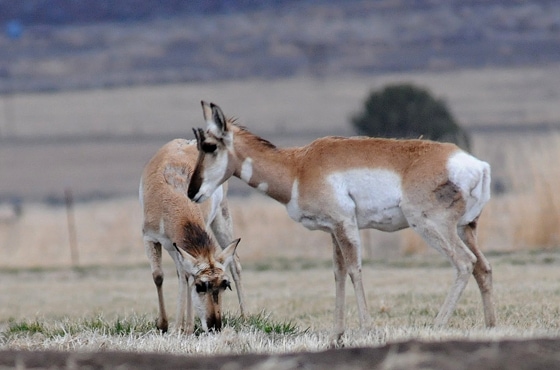
Bruce Mast is a veteran birder, field trip leader, lecturer, photographer, and GGBA boardmember. His birding quests have taken him to far-flung corners of Africa, Southeast Asia, Central and South America, as well as all over North America. When he’s not birding, Bruce likes to help people reduce the GHG emissions from their homes.
Editor’s note: If you would like to experience Sage Grouse for yourself, we currently have one spot available for our March 22nd trip. For more information and registration go to https://goldengatebirdalliance.org/birdathon-2019-fundraising-trips/
